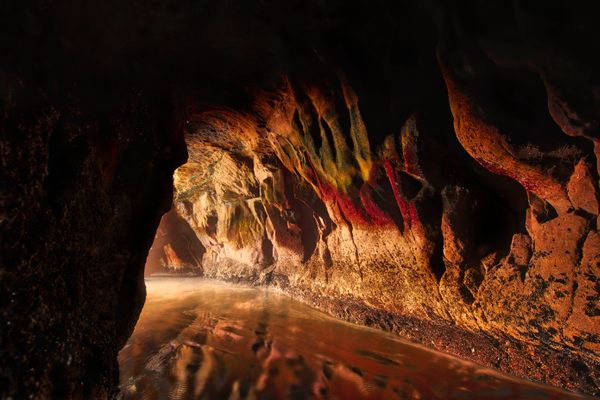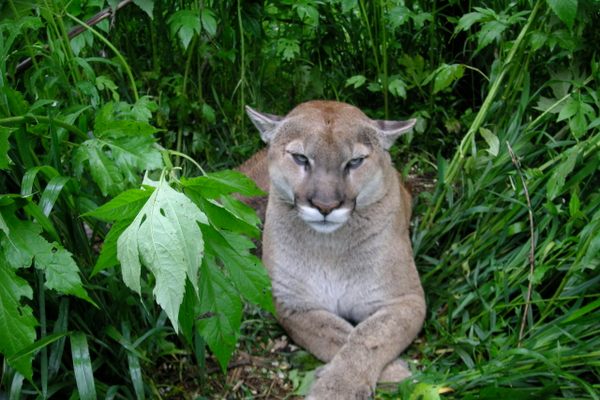A 1902 Panther Escape Becomes Political
Ido Michaeli’s new tapestry, “Black Panther Got Loose From the Bronx Zoo,” brings allegory to a zoo breakout.

Last Monday, a seven-year-old bobcat named Ollie snuck out of her cage at the National Zoo and began roaming the streets of Washington, D.C. She quickly gained an empathetic fan club and a Twitter account. When she was recaptured, near the zoo’s birdhouse, it only heightened her relatability. “We’re all Ollie the Bobcat, aren’t we?” asked Petula Dvorak in the Washington Post.
Animals escape zoos every year. Although many are urged on by adoring crowds, most (except the flamingos) are eventually caught. But there’s at least one mammal that stayed loose, and has inspired fellow-feeling, zookeeper lore, and art for over a century—the black panther from the Bronx Zoo.
“It’s a very accurate allegory for nowadays,” says Ido Michaeli, an artist who recently designed a tapestry based on the panther’s tale.

On a sunny July day in 1902, a seven-month-old panther arrived at the Bronx Zoo, a gift from the Mexican Zoological Society. Unable to move him into his permanent cage immediately, keepers left him overnight in his transit container, a slatted wooden box. “There had been no thought of the panther’s teeth in the building of the prison,” wrote the New York Times the next day. By 10:00 the next morning, he had gnawed a hole in the box and waltzed out.
For the next several hours, the Times reported, all of the Bronx was in thrall to this panther. The keepers came out in full force, with nets and chains, and passers-by who were lucky enough to spot the animal gawked as he leaped from chestnut tree to chestnut tree. “Picnic parties were all up and making for spots of safety,” the Times wrote. The panther snacked on the leftovers, and even in this, reporters gave him the celebrity treatment: “He Eats Sandwiches and a Ham for Lunch,” the dek of the Times article read, “but Balks at Pie.”

After a day of entertaining the crowds and and teasing his would-be captors, the panther finally made for the northern end of the Bronx Botanical Gardens, which was overgrown and jungly. From there, as his pursuers prepared for a final push, he leapt into the Bronx River. “It splashed into the water, and then they saw it swimming, with fine, vigorous strokes, which in a couple of seconds took it to the opposite shore,” wrote the Times. “Then the figure shook itself, looked back as if in triumph, and walked slowly into the jungle again.”
It’s difficult to hear this story without feeling some of that triumph yourself. But when Michaeli first came across it, he heard something else echoing in the panther’s tale—political allegory. “It was like a prison escape or a runaway slave,” he says. “The wild animal was taken from his natural habitat and put in a cage, and he struggled until he managed to liberate himself … All of these stories and metaphors came across my mind.”
Michaeli makes all kinds of art—stained glass, postage stamps, garden installations—but lately he’s been interested in tapestry. For this newest piece, Black Panther Got Loose From the Bronx Zoo, now on display at the American Jewish Historical Society, he transformed the story of the panther’s gambit into a hand-woven tableau, in which the story turns the form on its head.

“In the past, tapestry reflected the view of the rich and powerful,” he explains. Your average wall hanging would depict, say, noblemen taking down a stag that’s helpless in the face of their will. In his tapestry, Michaeli strove for the opposite effect. “This time, the natural and the wild enters the urban environment, the streets of the Bronx, challenging the established order,” he says. The panther, snarling, has his paw up on a fire hydrant. Perched on horses, the policemen and zookeepers resemble princes of old—one has his megaphone tilted like a hunting horn—but they’re far from capturing their quarry.
Michaeli’s visual retelling of the escape is somewhat embroidered. The Times article it was based on doesn’t mention firemen or police going after the animal, just hapless zookeepers. And the panther in question was not the black panther used as a symbol by the storied activist party, but more likely a jaguarundi, a smaller, brownish-gray species from Central America.
But—as we’ve learned from Ollie—animal escapes are, in the end, made of human dreams. And none of it matters to the panther, who, we can all hope, lived out a long, strange, free life in the Bronx.































Follow us on Twitter to get the latest on the world's hidden wonders.
Like us on Facebook to get the latest on the world's hidden wonders.
Follow us on Twitter Like us on Facebook